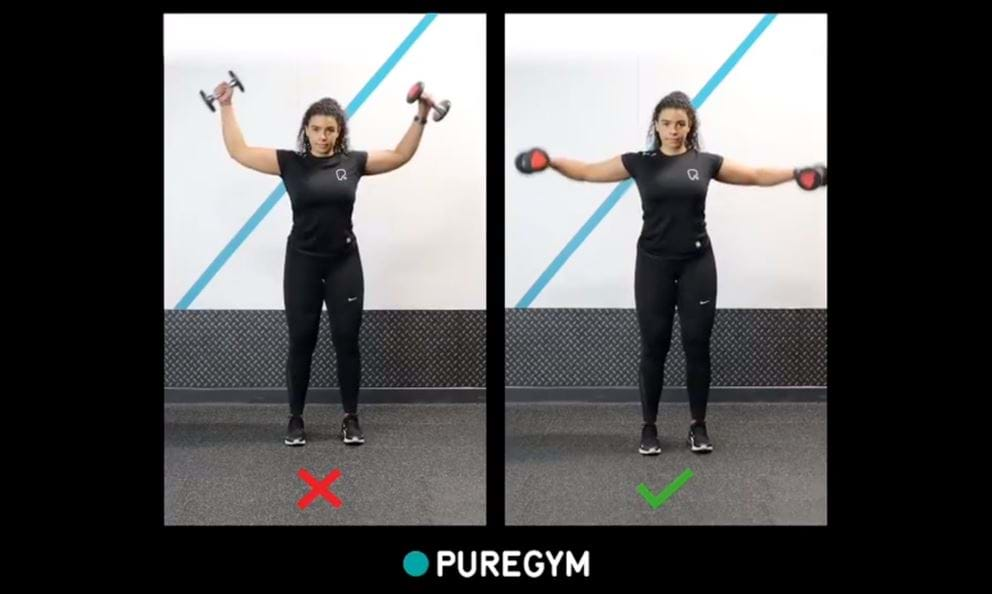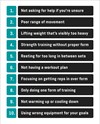Most common gym mistakes and how to avoid them

Getting started at the gym can be an exciting time. With our motivation at an all-time high, there's no better time to take advantage of it to hit the ground running to smash our fitness goals. However, with new equipment and classes to navigate, it's a lot easier said than done.
As with starting anything new, it's common to make mistakes along the way and that's okay but it can help to know the most common pitfalls when it comes to the gym so you can avoid injury and enjoy keeping fit for life.
To help you fast-track your progress, we asked our gym managers (who are all qualified personal trainers) to identify the most common training mistakes and how to correct them.
TOP 10 TRAINING MISTAKES MADE IN THE GYM

HOW TO OVERCOME THESE COMMON GYM MISTAKES
1. Not asking for help if you’re unsure of how to use a piece of equipment
At school, at work or in pretty much any other area of life, the best thing to do if you’re unsure of how to do something, is to ask someone. The gym shouldn’t be any different, and with fully qualified personal trainers on hand at our gyms, there couldn’t be anyone better suited to answering your questions. It might seem scary at first, but after that first question, you’ll realise that everyone is friendly and aiming towards goals similar to your own. Asking questions is always the best policy, and before long you might find yourself answering questions rather than asking them! We also have simple guides on how to use the most popular gym machines to help you get started.
2. Poor range of movement (only doing partial reps)
Nearly half of the UK’s gym managers (47%) said the most common mistake they see is people doing a rep with a poor range of movement.
A rep (aka a repetition of a specific exercise in a workout routine) can be anything from a squat to a bench press to a sit up to a bicep curl. When performing reps, you will typically want to perform full range of motion to reap the benefits of building muscle and strength.
A partial rep means performing your specific exercise with a very limited range of motion (i.e. a half squat rather than a properly executed full deep squat). This is typically included in a routine if you are looking to overcome a plateau, have mobility issues, are working on your form and technique, or are recovering from an injury.
If you're looking to build muscle or improve your strength, and partial reps aren't in your training programme, don't be afraid to take the time in learning how to perform exercises properly with a full range of motion, even if that means having to reduce the weight.
3. Trying to lift weights that are visibly too heavy for you (eg. ego lifting)
While it's great to see gym-goers pushing themselves out of their comfort zone, there's a fine line between challenging and overexerting yourself. Lifting weights that are too heavy for you is potentially dangerous (if the extra weight affects your form and technique, you could severely injure yourself), and it's not a very sustainable way to build strength and muscle. If you want to maintain making progress and avoid injury, finding right sized weights that both challenge you and allow to you to maintain decent form.
One of our managers surveyed recommended a way to find the right sized weights:
“Before going for heavy weights, it’s so important that you make sure that your technique is spot on. To find the best weight for you, start with a lighter weight and do as many well-formed full reps in a row as you can. If you can do more reps than you’re aiming for in a single set (10-15 for example) then you can increase the weights. If you can’t complete your desired amount of single set reps, then reduce the weight!”
4. Weight training without the proper form
If you're new to the gym or in the slightest doubt (or even if you’re confident, it’s never going to be unwise to double check) don't be afraid to ask a personal trainer for form advice when using weights and machines. Learning how to weight train properly is a skill which takes time so don't be afraid in taking that extra time to nail your form before upping the weights. As a guideline, when executing strength training exercises remember to think A.C.E (Abs engaged, Chin in a good position and not over Extending).
For advice on good technique when it comes to each exercise, our Instagram is a great place to go to iron out any issues with your form. Just ‘save’ posts like the one below for later, and pull them up to reference when working out! Or explore our Exercise guide which covers How-tos for a variety of exercises targeting different muscle groups.

5. Taking breaks that are too long between sets
When strength training, resting between sets is a necessity when it comes to getting an effective workout, and also avoiding injury. However, taking too long to rest and recover between sets can hinder your progress or have an adverse effect. If your heart rate lowers to a point where your muscles cool down too much, this could cause strains or tears in the muscles. As a rule of thumb, if you're doing less than 6-8 heavy reps, aim to rest between 2-5 minutes in between your sets. If you're doing more than 8-10 reps aim to rest anywhere between 30 and 90 seconds in between your sets. But again, it’s always worth asking a qualified personal trainer as this rest period can depend on the workout and your goals.
6. Making your routine up as you go along/not having a workout plan
It's easy to get lost with what to do in gym without a plan that you could find yourself spending more time figuring out what to do rather than working out. If you go into the gym with a plan, it's much easier to stick to it than without one. Allow your plan to be flexible (for example to have back-up options if equipment is busy, or a couple of options to avoid getting bored) so you have a good idea of the type of exercise and muscle groups that you want to work, and ways in which you can work them. Find some basic workouts plans for cardio and weight training here.
One gym manager encourages gym-goers to “Keep a plan the same for 6-8 weeks, or until you start to plateau and then you can mix it up again. If you have a plan, you’ll more likely stay focused on what you need to do and be more efficient, rather than just ending up doing exercises which may not be aligned with your goals or ending up spending hours in the gym."
7. Focusing on doing reps quickly, rather than correctly
Similar to the issue with partial reps, focusing on just getting through your set of reps rather than taking the time to make sure you’re doing them properly won’t help you reach your fitness goals. Speed won’t help you build strength if you’re whizzing through reps, as one of our gym managers explains:
“The time in which your muscles are under tension is important. Make sure to perform exercises correctly and with control to ensure your muscles are being used as opposed to gravity doing the work. In turn, you'd be more likely to see greater results than rushing through reps. Studies show that the majority of muscle build comes from completing completing reps that are controlled, so this is essential to success!”
8. Only ever doing one form of training (eg. cardio/training chest for days on end)
To a certain extent, doing the same type of training over time will be required for the majority of gym-goers in order to see progress (and perfectly fine if it's just about doing something you really enjoy!) but it's good to bear in mind that if you hit a plateau and you've not changed anything in your routine, it might be a good time to reflect if you need to make some changes to your routine. As your body adapts to your training and as you get fitter or stronger, you'll need to adapt your training accordingly. Same goes with working out a particular muscle group for a long period of time - you might want to work the opposing or surrounding muscle group to avoid muscle imbalances.
Mixing things from time to time can also help to keep things interesting if you are losing interest in your workouts. Your time at the gym shouldn’t feel like a chore, but instead something you look forward to, as you can think ahead to the new exercise you’re going to try, the class you’re booked in to, or the added weight you’re going to lift since last time.
To help you get started, we’ve put together at set of workouts for first time gym goers here. Alternatively, download our app for even more workout ideas, so you’re avoiding going through the same motions during every visit.
9. Not warming up before or cooling down after a workout
Whether you’re doing cardio or strength training, including a warm up before your workout and a cool down after your workout is a real must. We know it can feel pretty mundane but this will help to get your body prepped to do and recover from the workout, that in turn will keep you training and help to avoid injury in the long run. Nobody wants to be forced out of sticking to their fitness plans because they’re too sore or even injured from not stretching!
From static to dynamic stretching, there’s many different forms of stretching, so speak to a PT to find out which would work best for you, and the type of workout you’ll be doing.
10. Using the wrong machines/equipment for your fitness goals
A huge 71% of our gym managers voted that the main misconceptions gym goers have when it comes to training towards their goals are that ‘cardio is the number one way to lose weight’ and ‘lifting weights will result in a bulky physique’. By writing off certain types of equipment, you could be unintentionally be halting your progress, missing out on things you might find you enjoy doing or even losing out on health benefits that can come with certain exercises.
The wealth of information online can be overwhelming at times, so once again if you’re ever unsure of the equipment in relation to the goal, the best policy is always to ask! Then, setting these mistakes straight will help you to not only reach your goals, but surpass them! We also have workout plans for different goals on our app which is available to our members and includes demos of how to use equipment safely and effectively!


